In the water area shallower than the depth of 1,000 meters, cables are buried under the seabed mainly by two ways in order to protect them from damages, which might be caused by fishing activities or anchors of large vessels.
The one is to use the towed type burying machine, PLOW-II, which performs the simultaneous operation of cable laying and burial.
PLOW-II makes the installation period shorter because of the simultaneous operation of cable laying and burial, and is suitable for new and long distance operations.
Since PLOW-II is towed by the vessel on the seabed after threading the cable through it, it cannot be used for the burial operation after laying(burial after laying).
The working area of PLOW-II is limited depending on the seabed form or the slope.
The other is burial by ROV(MARCAS-IV, MARCAS-V).
ROV digs, by blasting waterjet into the seabed, a trench with the targeted burial depth by coming and going several times at the same section, and drops the cable into the trench. Because of this method, the construction efficiency of ROV is not better than PLOW-II.
However, ROV has the capability that it can float and move around on the sea bed, and ROV can work for the carved cable section which was caused by the final bight release, or in the area where PLOW-II can not be operated due to severe condition of the seabed.
Example of Cable Searching and Burial after Laying by ROV
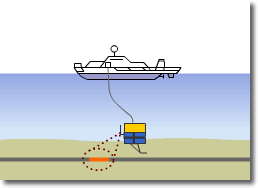
1. Launching ROV and Localizing Failure Point
The cable ship arrives at the cable failure point which is estimated by the electrical and optical measurement from the cable landing station in advance. The ship launches ROV onto the seabed. The precise cable failure location is specified by using the subsea cameras and cable sensors system of ROV.
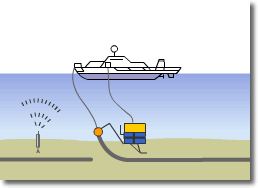
2. Cable Cutting and Cable Recovery
ROV cuts the cable failure section by the manipulator and cutting tool. It attaches the cable holding tool(gripper) to either cable end. After connecting the gripper with the rope paid out from the ship by the manipulator, the cable is recovered onto the ship. The transponder is installed around the other cable end, and ROV is recovered onto the ship.
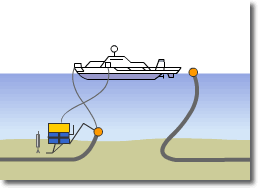
3. Buoy Installation, Cable Search and Recovery
The buoy is attached to the cable on the ship, and is released once on the sea. Again, ROV is launched on the seabed, and searches the cable's other end relying on the transponder previously installed. By the same procedure as above item 2, the cable is recovered on the ship.
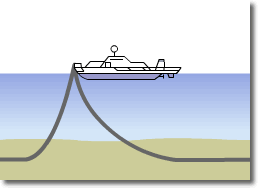
4. Insertion of Spare Cable and Cable Jointing
The recovered cable in above item 3 and the spare cable in the ship are jointed. After the jointing, the ship approaches to the buoy in the item 3 laying the spare cable, and recovers the buoy and cable. After jointing the laying spare cable and the recovered cable, the cables are released to the seabed.
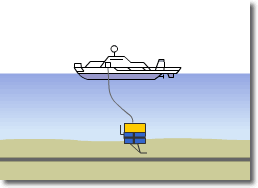
5. Cable Burial after Laying
The attached spare cable and the exposed cable on the seabed due to the repair work are buried under the seabed by the waterjet of ROV.






